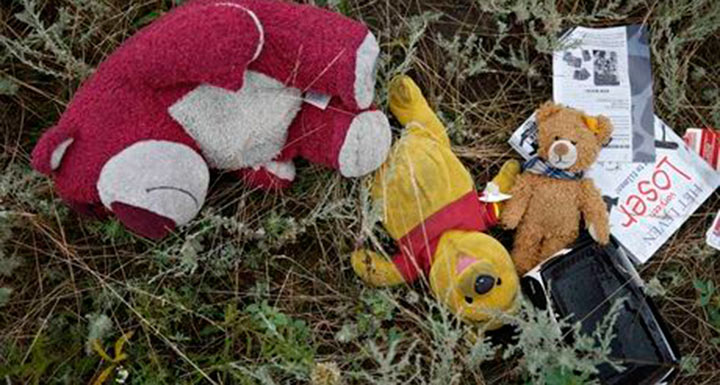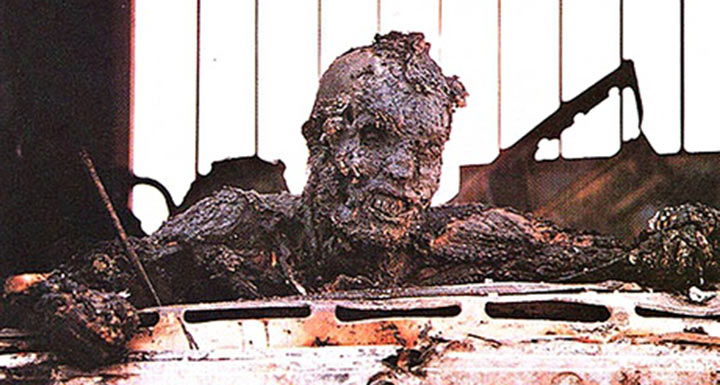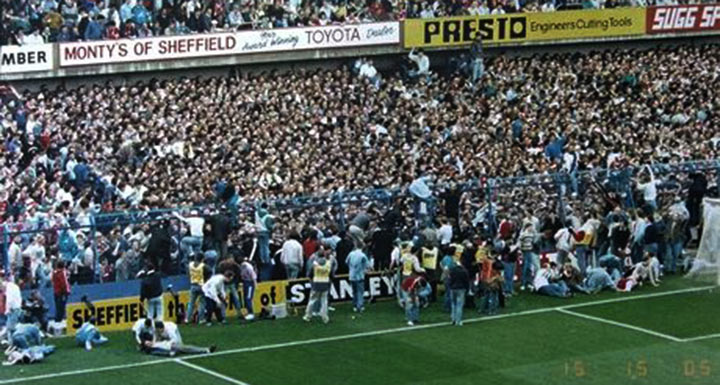
Graphic content: when photographs of carnage are too upsetting to publish
The onslaught in Gaza and the MH17 crash scene in Ukraine have generated thousands of pictures, many of which show the gruesome reality of the violence. How does the Guardian's head of photography decide whether or not to use such images?
“I really can’t bear to look at that picture for more than a moment, it’s just too upsetting.” That was the reaction of my colleague, an experienced picture editor, to a photograph of a man kissing his dead child in a Gaza morgue on Tuesday. We were discussing its possible use in the paper. We wanted to show the readers the reality of life – and death – in Gaza but we didn’t want to shock or unnecessarily upset them. We tread a fine line and, because each picture is judged on its merits on the day, it is very difficult to have hard and fast rules.
It’s been another bitter, bloody and deadly news week. The images coming in to the Guardian’s picture desk have reflected the last few days’ carnage in an even more graphic way than usual: dead and maimed children in bombed-out Gaza or bodies of victims lying in Ukrainian cornfields. Conflict-weary picture editors have shed tears and wondered aloud if counselling might be needed as they have shifted through thousands of pictures provided by the photo agencies’ all-seeing lenses.
Two headline-grabbing and violent events – the downing of Malaysian Airlines MH17 in Ukraine and Israel’s assault on Gaza – have generated some horrific photographs on a seemingly unprecedented scale. Of this flood of images, there are hundreds that we would not choose for publication because they are either deeply shocking, insensitive to human dignity, would be painful if seen by relatives or friends, or ultimately run the risk of forcing readers to turn away from the story, which would negate the purpose of photojournalism.
And there are deeper issues that we, as picture editors, have to wrestle with. Might we be doing the victims a disservice if we do not publish such hard-hitting photographs? If you had died a violent and unjust death, wouldn’t you want the world to know all the details surrounding that death? On the other hand, in showing those images, are we perhaps feeding a propaganda machine and fuelling more conflict?
During the Gulf war, in 1991, I took a telephone call from a reader. She told me that the Guardian wasn’t showing enough of the brutality of war, we must be holding back pictures, and she felt patronised by our photo coverage. Was this to be the first electronic war, with video footage of targets being blown up by remotely fired missiles and nothing showing the victims of all that hi-tech ordnance? A few days later, first the Observer and then the Guardian published Kenneth Jarecke’s chilling photograph of an Iraqi soldier sitting in his truck having being been incinerated (there’s no other word) during an attack on the fleeing Iraqi forces that was later described by the Americans as a “turkey shoot”.

This week, back in the Middle East, many of the pictures of the dead from Gaza have involved children. These can have a special resonance for the parents among us, but there have also been images of the airline passengers’ bodies in Ukraine, scarcely covered by black plastic sheets.
So many of these images provoke personal feelings, which make the job of editing more difficult. However, we must not lose our human empathy: most of the time, that can be a pretty good prism through which to view and judge what is palatable to publish.
I am sure all other newspaper picture desks have been struggling to keep up and cope with this onslaught of troubling imagery. By and large, the UK papers have been non-sensationalist in the pictures they have published. They have concentrated on recording the deaths of the MH17 passengers by publishing portrait pictures of as many of the victims as could be tracked down – often using photographs that are, I suspect, grabbed from a Facebook page. One picture of the Allen family, all five of whom were killed in the disaster, has stood out as particularly poignant.
And, just like the Guardian, other papers have also portrayed the all-too-personal details of the detritus left on the ground amid the burned and twisted wreckage: a pair of glasses; a paperback book; a half-eaten Toblerone. These are almost as heartbreaking a sight as the body-bagged corpses that once owned them. On the other hand, the plight of the children in Gaza hasn’t troubled the UK red tops too much; they have been distracted by the first birthday of another child in Kensington.
Over the years, I have seen many disturbing photographs. In my first few weeks on the Guardian picture desk, the Lockerbie disaster happened: there were far fewer photographs being shot in those days, but the image of body shapes left imprinted in the soft grass of a meadow is still seared into my mind. Then there were the awful photographs of Liverpool football fans cruelly pressed against the crowd-control fences of Hillsborough: surely those people couldn’t be dying on that spring afternoon? Yes, many were indeed dead, their deaths caught on film by the astonished sports photographers who were there to record the match.
The harrowing pictures of 9/11 victims jumping from the towers of the World Trade Center are rarely seen now, but on that world-changing day, they showed humans in absolute extremis and are completely unforgettable. But who recalls the close-up of a dismembered hand lying on a city pavement, a picture that found its way on to the pages of one London tabloid? I certainly do. How on earth did that get published?

Of course, editors had to make many quick decisions that day, and some were more questionable than others. A lot has been written about how the internet demands immediate, unverified imagery and how that is leading to bad publishing decisions, but it has always been thus. A newspaper is put together by a team of individuals with different sensibilities under strict time constraints. Choices are made on the fly, following mostly unwritten rules; it’s very easy to regret some things in the cold light of the next morning.
Since 9/11, we have been sent pictures of the butchery wrought by other suicide bombers on themselves and others: broken bodies hanging out of cars; torsos and heads on pavements. There is one photograph in our archive of just a face torn from a body. As picture editors, we have got used to viewing bloodied body parts on our office screens as part of our role. Sometimes, I wonder why a photographer hasn’t turned away from a scene, but their place is to record; ours is to edit.
In addition to the thousands of photographs supplied by the main wire agencies, such as AP and Reuters, the most prestigious photojournalists’ agency, Magnum, has been offering a set of images taken by Jerome Sessini from the MH17 crash site. Sessini certainly didn’t hold back and recorded bodies lying in fields where they fell and, in one case, in a room of a local house, having crashed through the roof. This is an astoundingly dark picture. It is basically a still from a horror movie: the person involved has been accorded absolutely no shred of dignity. Magnum was, I think, wrong to offer this picture for sale and indeed followed up the initial email offering the set with another apologising for not warning of the nature of content on offer. The pictures shocked me when I opened the email, but I was shocked again to see them published on Time.com as a photo essay. Time prefaced them with the words, “Warning: some of the following images are graphic in nature and might be disturbing to some viewers.” Surely that is more of an invitation to the prurient rather than a warning? This has ensured they have travelled around the world on social media, just like the tweeted pictures of dead children from Gaza that Guardian columnist Suzanne Moore wrote about this week.
But, in the end, what right do I have as a picture editor to censor what people can see? It’s all out there on the internet or on your timeline. All I can do is try to help keep the Guardian’s coverage as humane and decent as possible.

